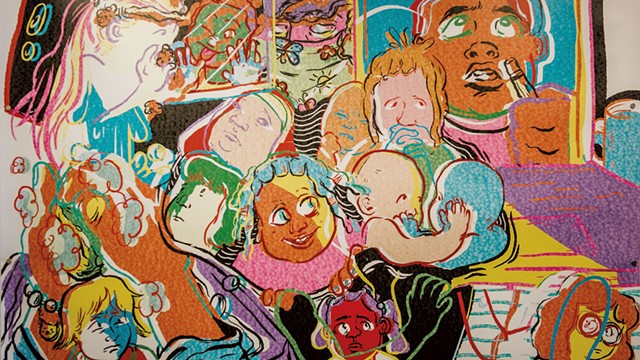
- Courtesy Of Sam Simon
- "March to Now" by Lillie Harris
The BCA Center's absorbing group show "Unprecedented?" brings together work in a variety of mediums by nine artists, seven of whom are Vermonters. Using ceramic vessels, multipanel photographic works, a cartoonist's print, a multimedia installation and two large-scale sculptures, the artists respond to the tangle of emotions inspired by current times.
"Unprecedented?" replaces a different exhibition planned for the Burlington gallery that was canceled because of the pandemic. In one sense the show itself is unprecedented, at least in curator Heather Ferrell's experience: She created it within a few months — a nanosecond in the art-curation world. Many of the works were commissioned for this exhibition, which means the artists stepped up in record time, too.
The exhibition is meant to question how "unprecedented" this moment really is. As the introductory wall text reads, that word "has trended with ferocious speed ... to describe the global pandemic and growing demonstrations for racial justice. ... [Yet] it seems questionable that these circumstances are either unprecedented or unpredictable."
Visual art is just one method of interrogating those ideas in the show. Community discourse appears equally important. Besides the curatorial labels, which often begin with the artists' own words, the exhibition features labels offering the thoughtful commentaries of five community members in response to the art.
The show's title itself signals the importance of engagement in "Unprecedented?" While the question mark indicates an invitation to discussion, the word is also stylized with a backward-upside-down "e." The latter is positioned after the "c" as if in dialogue with the "e" before it, or symbolic of a glance backward in time.
EvnNSteve, the Pawlet couple of photographer Stephen Schaub and author Eve O. Schaub, employ that backward glance to explore the ambiguity of race and restorative justice in their extensively researched "The Home of My Choice." The work consists of nine in-camera film collages of images that Stephen shot at the Old Stone House Museum & Historic Village in Brownington: unpeopled glimpses of granite, clapboard, windows, chairs, clouds and trees.
Eve penned winding lines of cursive and printed text that appear directly on these black-and-white images on Japanese paper. The text elucidates the known, guessed-at and rewritten history of Alexander Twilight, who built the structure to house his school in 1836.
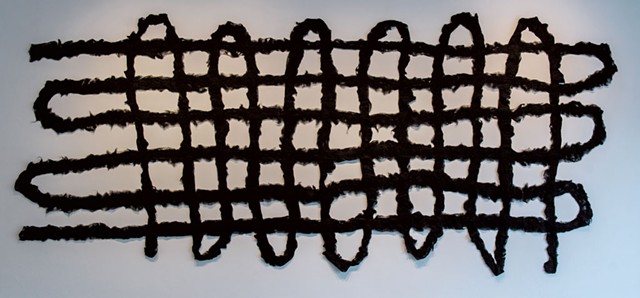
- Courtesy Of Sam Simon
- "Sometimes I recall our hair grows after death" by Akiko Jackson
The work focuses on Twilight's contested race and its shifting importance in others' eyes over time. In 1974, Middlebury College claimed Twilight as the nation's first Black college graduate, though others have identified him as white when convenient, including during his lifetime.
As Carmen Jackson, board president of the Old Stone House Museum, writes in her commentary on EveNSteve's work, what is known about Twilight is that he was a devoted educator who chose the Northeast Kingdom as his home.
EveNSteve's other work in the show, "A Wonderful Plague," draws parallels between the current pandemic and former scourges such as the AIDS crisis and the Black Plague.
Montpelier-based cartoonist/illustrator Lillie Harris explores the lateral impact of the coronavirus pandemic on children in her 48-by-64-inch "March to Now." In a riot of alarming colors, Harris depicts a crowd of disconnected young faces, from babies to schoolchildren, expressing every imaginable emotion. They appear to be caught in a torrent of blue water on the left and captured on a large laptop screen on the right — or squeezed between the two.
"It seems like every day has housed a cataclysmic event," Harris writes. "This year feels like a decade," responds Tamara Waraschinski, a mother and company manager of JAG Productions in White River Junction, in her commentary.
Several works seem more powerful for being pared down. Rhode Island-based artist Akiko Jackson's two large-scale sculptures in the BCA's back room (which overlooks the renovated City Hall Park) each use a single medium and color. In "neckbones," vertebrae made from a warm-yellow cast resin have been strung together and hang in a jewel-like arrangement from the ceiling.
Jackson's bodily reference captures both the pain of witnessing repeated killings of "marginalized black and brown bodies," as she writes, and the hope of healing. The Hawaii-born artist's mother is Japanese.
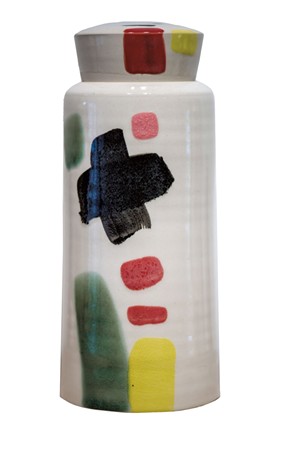
- Courtesy Of Sam Simon
- "Jar that can be used as a vase, When you accidentally break the lid" by Dan Siegel
Jackson's "sometimes I recall our hair grows after death" commemorates the death of her last grandparent, a moment of which she was the sole witness. She used synthetic hair and wool, both black, to create a kind of wall weaving formed of two overlaid strands that loop back and forth in opposite orientations — one vertical, one horizontal. Simultaneously a minimalist grid and an organic embodiment of grief, the work reads like a life crossed out.
In his commentary, Milton Rosa-Ortiz, an artist and oncology nurse at the University of Vermont Medical Center, relates the work to cancer patients in his care.
Resonating with Jackson's work are five white-striped black ceramic urns by Jeremy Ayers of Waterbury. Not all of the four ceramic artists' vessels reference death, however. Dan Siegel of Burlington humorously names his five colorfully glazed jars for their uses, which range from practical ("Jar for a questionably fermented kimchi, A different shape would have been better") to numinous ("Jar for your last breaths, You are a new person now").
Burlington ceramic artist Brielle Rovito's five vessels, collectively titled "Matriarch Internalizing," have smooth white slip-cast surfaces interrupted by boils, symbolizing women's internalized stresses under pandemic conditions that have limited venting to friends, according to Rovito's comments. One of the boils has burst.
That work brings to mind society's long-repressed boils of anger at Confederate monuments. The commissioning and funding of such monuments by Southern white women is documented in Rhode Island artist-activist Becci Davis' "In the Shadow of Dixie" — a detailed and damning multimedia installation that deserves thorough study.
"Unprecedented?" reminds viewers that, while viewing art in person is something of an escape these days, it can also help us process exactly what we wish to be farthest from.

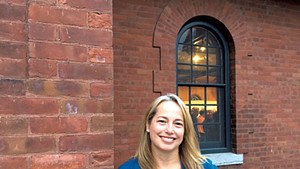
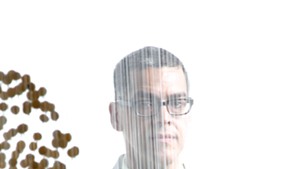









Comments
Comments are closed.
From 2014-2020, Seven Days allowed readers to comment on all stories posted on our website. While we've appreciated the suggestions and insights, right now Seven Days is prioritizing our core mission — producing high-quality, responsible local journalism — over moderating online debates between readers.
To criticize, correct or praise our reporting, please send us a letter to the editor or send us a tip. We’ll check it out and report the results.
Online comments may return when we have better tech tools for managing them. Thanks for reading.